Mobile Sharing and Companion Experiences for Microsoft Teams Meetings
Use your computer and phone together in video meetings

“I was showing the whiteboard through the phone to the remote participants. It genuinely helped the course of the meeting.”
About Mobile Sharing and Companion Experiences for Microsoft Teams Meetings
Our devices should work together as flexibly as we do. Video meetings traditionally limit each person to one device at a time, but many meeting tasks would be easier with two. In Microsoft Teams you can now use your computer and phone together in meetings, without conflict, for more flexible communication, sharing, and control. You can use Companion Experiences to solve lots of everyday video meeting problems.
Remote users can feel left out when physical surroundings can’t be seen clearly from a computer or room camera. In a Teams meeting, just join your phone as a companion and you can present live mobile video or a photo. Whatever you are presenting from your phone will be shown on your computer the same way everyone else sees it.
It can be difficult to present an app on your phone or content that is only on your phone to a meeting. In a Teams meeting, just join your phone as a companion and you can present your phone screen. In fact, you could start a meeting without remote participants and just use this feature to project your phone to the room.
If you want to remote control PowerPoint so that you can move around while talking, this has previously required using multiple systems (e.g. a videoconferencing solution and PowerPoint on both desktop and mobile, or a videoconferencing solution, PowerPoint on desktop, and a dedicated remote control).
In a Teams meeting you can do it all in one. Start PowerPoint on your computer and control it from your phone. As with presenting your phone screen, you could just start a meeting without remote participants to use this for local presenting. As an added bonus, if anyone else does join the meeting, they can also independently review your deck and request to take control. This can be great for Q&A sessions, or a way around the time-lags between presenters. Combine your decks in Teams and then each presenter can take control when they need to.
Finally, if you’re coming into or leaving work, changing your meeting between your phone and your computer can be difficult. It often involves hanging up one device to switch to the other. In a Teams meeting with your phone joined as a companion, you can toggle your video, speaker, and microphone between computer and phone – in any combination, so you can seamlessly move between devices.
Companion Experiences versions are being rolled out to all desktop, web, iOS, and Android clients through 2018. Your access to features may vary as the features are being released incrementally. Live mobile video, photo, screen sharing, and PowerPoint presentation will also be available as standalone mobile features (see Teams On Air: Ep. 68 A day in the life on Teams Mobile Client).
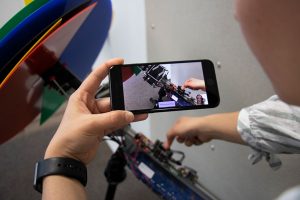
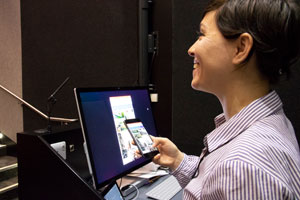
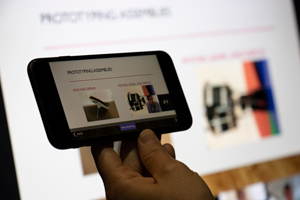
Video
Journey
Research into Computer-Supported Collaborative Work has explored problems of disengagement in video meetings and device conflict since the 1990s, but good solutions that could work at scale have been elusive. Microsoft Research Cambridge UK had been working on these issues when the 2015 Hackathon arose as an opportunity to highlight for the rest of the company that just a few simple and dynamic device combinations might provide users with the means to solve the issues themselves.
While we had explored some research prototypes in late 2014 and early 2015, for the Hackathon we decided to use a vision video with the goal of getting the attention of the Skype product group, because we knew that the idea would have the most impact as an infrastructural feature of an existing product rather than as a new stand-alone product. We called the video “Skype Unleashed” to connote breaking free of the traditional one person per endpoint model.
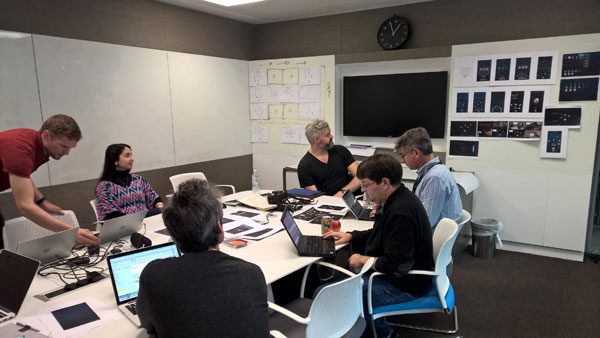
When we won the Business category, our prize was meeting with the sponsor of the Business category, then-COO Kevin Turner. We scrambled to build a proof-of-concept prototype, which at first we jokingly referred to as “Skype Skwid”, a deliberate misspelling of “squid”, because it was like a body that had lots of tentacles that could reach out to different other things. However, we realized that we needed an official project name, so we became “Project Wellington”. This was a related inside joke, because the largest squid in the world is the Colossal Squid, and the largest specimen in the world is in the Museum of New Zealand Te Papa Tongarewa… in Wellington, New Zealand.
So as Project Wellington we went to meet Kevin Turner, who also invited Gurdeep Singh Pall, then-CVP for Skype, in November 2015. Both immediately saw the relevance of the concepts and Gurdeep connected us to Brian MacDonald’s incubation project that would become Microsoft Teams.
Brian also understood right away that Companion Experiences could be an innovative market differentiator for meetings and a mobile driver for Teams. He championed the integration of our small Cambridge group with his Modern Meetings group as a loose v-team. The Modern Meetings group was exceptionally welcoming, graciously showing us the ropes of productization and taking on the formidable challenge of helping us socialize the need for changes at all levels of the product, from media stack, middle tier, and all clients. We, in turn, learned a lot about the cadence of production, scoping, aligning with the needs of multiple roadmaps, and the multitude of issues required to turn feature ideas into releasable code.Through 2016 and 2017 we worked on design iterations, usability testing, and middle tier and client code. We were thrilled when first glimpses of roving camera and proximity joining were shown at Build 2017, and then announced as officially rolling out at Enterprise Connect 2018.
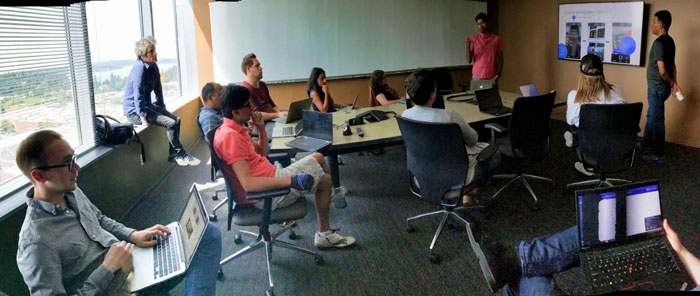
We are very excited to see these features released. We are also excited to close the research loop by evaluating our thesis that dynamic device combinations will improve hybrid collaboration in video meetings, and doing research ‘in the wild’ at a scale unimaginable by most research projects. Microsoft is one of only a handful of institutions that can make research possible that will improve the productivity of millions of people daily. So as well as releasing product features, we are exceptionally proud of the model of collaboration itself. And, indeed, we are continuing to collaborate with Microsoft Teams even after these features are released, as we now have a tremendous relationship with a product group that understands how we work and values our help.
To come full circle, then, it was Satya Nadella’s emphasis on the Hackathon as a valuable use of company time, and The Garage’s organization of the event itself, that allowed ideas well outside a product group to be catapulted to the attention of people who could see its value and then provide a path to making it happen.
If you would like to find out more about this project, connect with Sean Rintel on LinkedIn or follow @seanrintel on twitter.
Team
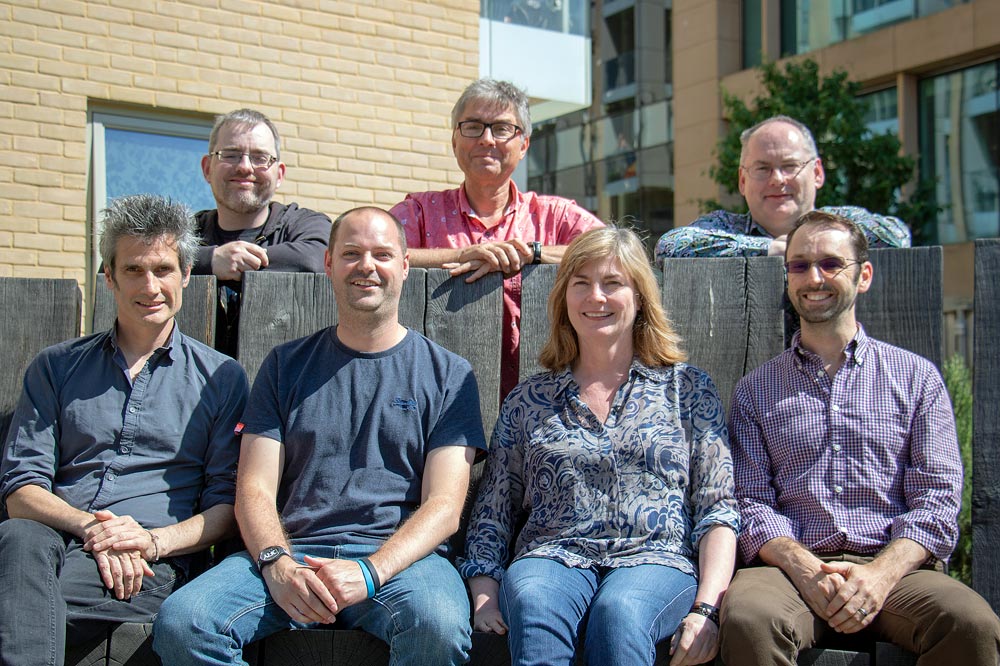
Bottom row left to right: Kenton O’Hara, Martin Grayson, Abigail Sellen, Sean Rintel
Top row left to right: Michael Armstrong, Tony Wieser, Gavin Smyth
Research contributors:
Hackathon: Kenton O’Hara, Sean Rintel, Abigail Sellen, Bob Corish, David Sweeney, Phil Gossett, and Gavin Smyth. Nick Chen, Advait Sarkar, Jane Gruning, and Stephanie Neumann helped with the hackathon video.
Project: Kenton O’Hara, Sean Rintel, Tony Wieser, Martin Grayson, Vassily Lyusatrev, Bob Corish, and Mike Armstrong. Oversight from Abigail Sellen and John Bronskill.
Special thanks to Chris Bishop, Director of the Cambridge Lab, for consistent support, and Richard Harper and Bill Buxton for early inspiration.
Roman Rädle also deserves special thanks for being central to building the post-Hackathon proof-of-concept.
Other FTEs, interns, and contractors who contributed over the course of the project were Henrik Sorensen, Debaleena Chattopadhyay, Behnaz Rostami Yegaheh, Kagonya Awori, Jens Emil Grønbæk, Mario Schreiner, Francesca Salvadore, and Ding Wang. Safinaz Büyükgüzel, Anusha Iver, Ruixue Liu, Christian Naesseth, Joseph Newbold, Sunil Rodger, Steindor Saemundsson, Hayden Scott-Baron, Banu Saatci, and Matthew Johnson helped with the release video.
Product Contributors:
Brian MacDonald, CVP of Microsoft Teams, championed the project.
Graham Sheldon, Mark Swift, and Jigar Thakkar provided LT support. Our collaborators in the thick of the work were the Modern Meetings and Mobile teams, distributed between Bellevue and Prague: Amey Parandekar, Ewin Davis Kannuthottiyil, Ruchir Astavans, Swati Jhawar, Jindrich Parus, Kevin Morrison, Jason Faulkner, Philipp Steinacher, and Dominic Rödel.
